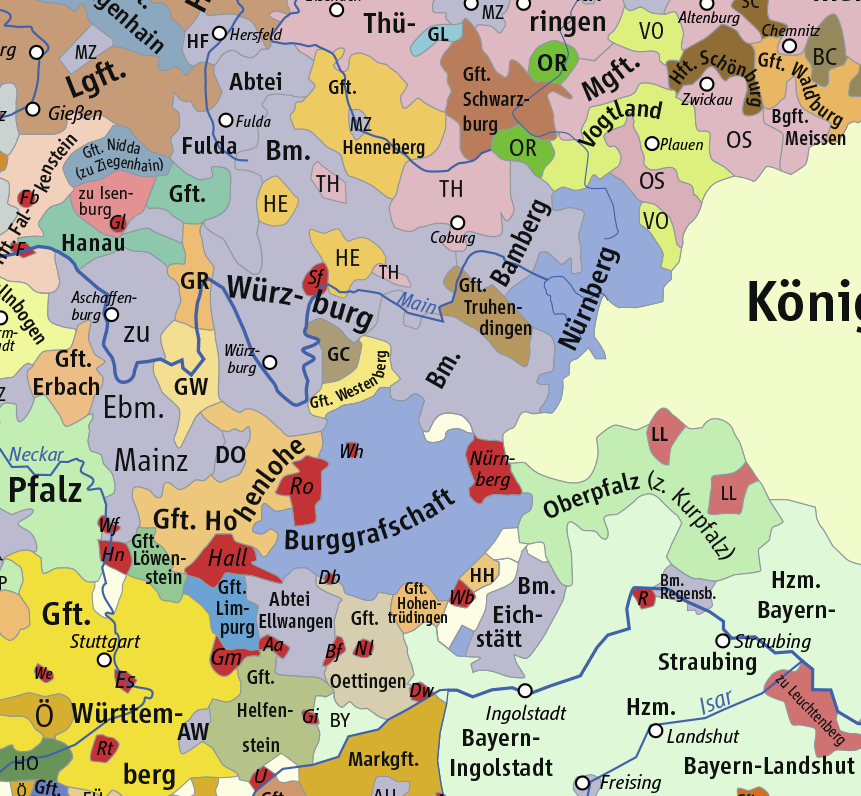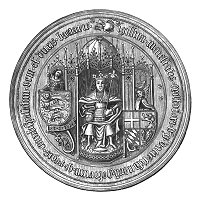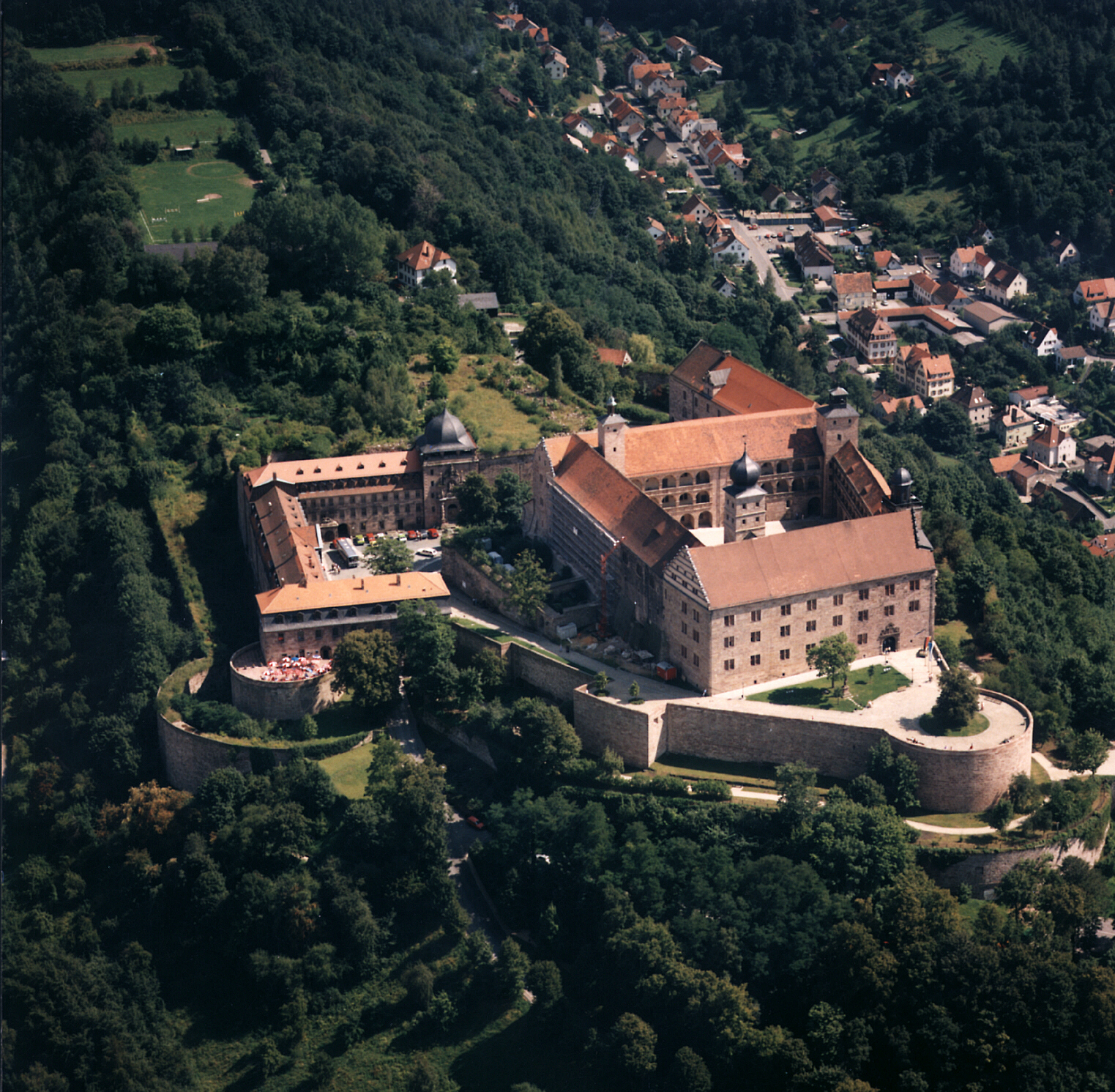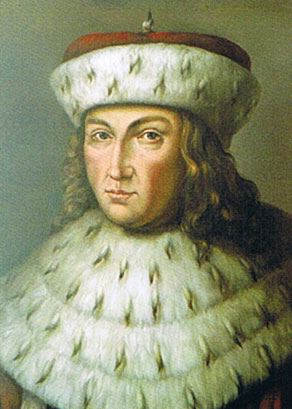|
Johann Der Alchimist
John, nicknamed the Alchemist (german: Johann der Alchimist; 1406 – 16 November 1464) was a Margrave of Brandenburg-Kulmbach and served as the peace-loving Margrave of Brandenburg after the abdication of his father, Frederick I, the first member of the House of Hohenzollern to rule Brandenburg. Biography John was the eldest son of Frederick I, Margrave of Brandenburg (1371–1440), and Elisabeth of Bavaria-Landshut (1383–1442), daughter of Frederick, Duke of Bavaria, and his second wife Maddalena Visconti. After marrying Barbara of Saxe-Wittenberg (1405–1465), daughter of Rudolf III, Duke of Saxe-Wittenberg, John hoped to eventually succeed to Saxe-Wittenberg once its line of Ascanian dukes died out. When this happened in November 1422, however, Emperor Sigismund was on poorer terms with the Hohenzollerns and was only willing to compensate John with a monetary payment. John began participating in governmental affairs in Brandenburg in 1424. Frustrated by disputes with the f ... [...More Info...] [...Related Items...] OR: [Wikipedia] [Google] [Baidu] |
Margrave Of Brandenburg-Kulmbach
The Principality of Bayreuth (german: Fürstentum Bayreuth) or Margraviate of Brandenburg-Bayreuth (''Markgraftum Brandenburg-Bayreuth'') was an immediate territory of the Holy Roman Empire, ruled by a Franconian branch of the Hohenzollern dynasty. Since Burgrave Frederick VI of Nuremberg was enfeoffed with the Margraviate of Brandenburg in 1415/17, the Hohenzollern princes transferred the margravial title to their Franconian possessions, though the principality never had been a march. Until 1604 they used Plassenburg Castle in Kulmbach as their residence, hence their territory was officially called the Principality of Kulmbach or Margraviate of Brandenburg-Kulmbach until the Empire's dissolution in 1806. Geography The Kulmbach-Bayreuth principality arose from the northern uplands (''Oberland'') of the former Burgraviate of Nuremberg, while the southern lowlands (''Unterland'') formed the Principality of Ansbach. The final border demarcation was settled by the 1541 House T ... [...More Info...] [...Related Items...] OR: [Wikipedia] [Google] [Baidu] |
Cadolzburg
Cadolzburg (outdated also ''Kadolzburg'', colloquially pronounced "Kalschbuʳch" or "Sporch" ) is a municipality in the Middle Franconian district of Fürth, in Bavaria, Germany. It is situated west of Fürth. Its name derives from its central castle, first being mentioned in the year 1157. Geography The topography varies significantly in its height. Neighborhood Neighboring Municipalities are: (beginning in the north then going clockwise) * Veitsbronn * Seukendorf * Fürth * Zirndorf * Ammerndorf * Großhabersdorf * Langenzen Districts Cadolzburg consists of the city itself and 15 farther districts: History Middle Ages The place was first mentioned in 1157 when the reeve of Kadolzburg, Helmericus de Kadoldesburc, agreed on a territorial exchange between the diocese of Würzburg the Heilsbronn Abbey. So the name derives from ''Burg des Kadold'' meaning "Kadold's castle". If the castle had been built by Duke Kadold, who in the year 793 founded the Herrieden Abbey, ... [...More Info...] [...Related Items...] OR: [Wikipedia] [Google] [Baidu] |
Upper Palatinate
The Upper Palatinate (german: Oberpfalz, , ) is one of the seven administrative districts of Bavaria, Germany, and is located in the east of Bavaria. Geography The Upper Palatinate is a landscape with low mountains and numerous ponds and lakes in its lowland regions. By contrast with other regions of Germany it is more rural in character and more sparsely settled. It borders (clockwise from the north) on Upper Franconia, the Czech Republic, Lower Bavaria, Upper Bavaria and Middle Franconia. Notable regions are: * Stiftland, former estate and territorial lordship of Waldsassen Abbey with the market town of Konnersreuth, Fockenfeld Abbey, the town of Waldsassen and about 150 other villages. * Upper Palatine Forest with deep valleys and many castles * Upper Palatine Lake District with the Steinberger See * Upper Palatine Jura, part of the Franconian Jura * Steinwald including the Teichelberg and Pechbrunn * Waldnaab/ Wondreb Depression * Bavarian Forest, together with ... [...More Info...] [...Related Items...] OR: [Wikipedia] [Google] [Baidu] |
Christopher Of Bavaria
Christopher of Bavaria (26 February 1416 – 5/6 January 1448) was King of Denmark (1440–48, as Christopher III), Sweden (1441–48) and Norway (1442–48) during the era of the Kalmar Union. Biography Coming to power He was the son of John, Count Palatine of Neumarkt (1383–1443) and Catherine of Pomerania (c. 1390–1426). Catherine was the daughter of Wartislaw VII, Duke of Pomerania in Pomerania-Stolp, and sister of the Scandinavian king, Eric of Pomerania. Count Palatine John was a son of King Rupert of Germany (1352–1410). Christopher was probably born at Neumarkt in der Oberpfalz in Upper Palatinate, in Bavaria, Germany. In 1445, Christopher married Dorothea of Brandenburg (1430 – 25 November 1495) in Copenhagen. Eric of Pomerania was deposed as king of Denmark and Sweden in 1439. Eric's nephew, Christopher, who was rather unfamiliar with Scandinavian conditions, was elected by the Danish State Council as the successor to his uncle, first as regent from 1439, ... [...More Info...] [...Related Items...] OR: [Wikipedia] [Google] [Baidu] |
Kulmbach
Kulmbach () is the capital of the district of Kulmbach in Bavaria in Germany. The town is famous for Plassenburg Castle, which houses the largest tin soldier museum in the world, and for its sausages, or ''Bratwürste''. Geography Location Kulmbach is located in the middle of the Bavarian province of Upper Franconia, about northwest of the city of Bayreuth. To the south of Kulmbach, the River Main begins at the confluence of its headstreams, the White Main and Red Main. Town districts Kulmbach is divided into the following districts (with population in brackets): History From about 900 AD there was a small settlement in what is now the district of Spiegel, which consisted of a forest lodge and a fortified tenant farm (''Fronhof'') to protect the river Main crossing at Grünwehr. The area later passed into the hands of the Count of Schweinfurt, whose power was usually exercised through the office of the . Kulmbach was first mentioned as ''Kulma'' in a deed of gift ... [...More Info...] [...Related Items...] OR: [Wikipedia] [Google] [Baidu] |
Plassenburg
Plassenburg is a castle in the city of Kulmbach in Bavaria. It is one of the most impressive castles in Germany and a symbol of the city. It was first mentioned in 1135. The Plassenberg family were ministerial of the counts of Andechs (later the dukes of Andechs-Meranien) and used as their seat the Plassenburg. The House of Guttenberg, a prominent Franconian noble family, traces its origins back to 1149 with a Gundeloh v. Blassenberg (Plassenberg). The name Guttenberg is derived from Guttenberg and was adopted by a Heinrich von Blassenberg around 1310. From 1340, the Hohenzollerns governed from Plassenburg castle their territories in Franconia till 1604. The Plassenburg was fortress and residence for the Hohenzollerns. It was destroyed in 1554 at the end of the second Margravian war (1552–1554) of margrave Albert Alcibiades. The Plassenburg was later rebuilt by the architect Caspar Vischer as an impressive stronghold and as a huge palace. In 1792, Margrave Alexander s ... [...More Info...] [...Related Items...] OR: [Wikipedia] [Google] [Baidu] |
Frederick II, Elector Of Brandenburg
Frederick II of Brandenburg () (19 November 1413 – 10 February 1471), nicknamed "the Iron" (''der Eiserne'') and sometimes "Irontooth" (''Eisenzahn''), was a Prince-elector of the Margraviate of Brandenburg from 1440 until his abdication in 1470, and was a member of the House of Hohenzollern. Biography Frederick II was born at Tangermünde Castle (German: ''Burg Tangermünde''), when Tangermünde was within the Margraviate of Brandenburg, to Frederick I, Brandenburg's first Hohenzollern ruler, and his wife Elizabeth, daughter of Frederick, Duke of Bavaria-Landshut, and Maddalena Visconti. The latter was a daughter of Bernabò Visconti and Beatrice della Scala. As the second son, his brothers included John the Alchemist and Albert Achilles, both of whom also ruled Brandenburg as margraves. In 1421, at age 8, Frederick was betrothed to Hedwig Jagiellon, but she died on 8 December 1431, before the marriage could take place. When Frederick I retired in 1437, he compensated hi ... [...More Info...] [...Related Items...] OR: [Wikipedia] [Google] [Baidu] |
Buch Der Heiligen Dreifaltigkeit
The ''Buch der heiligen Dreifaltigkeit'' ("Book of the Holy Trinity") is an early 15th-century alchemical treatise, attributed to Frater Ulmannus (latinization of the German given name ''Ulmann'', from OHG '' uodal-man''), a German Franciscan. The text survives in at least four 15th-century manuscripts, the archetype Cod. 78 A 11 (Berlin), dated to between 1410–1419, and three copies,: Heidelberg Cpg 843 Fasc. 3 (15th century); Munich, Staatsbibl., Cgm 598 (late 15th century, after 1467) and St. Gallen, Kantonsbibl., VadSlg Ms. 428 (dated 1488). The treatise describes the alchemical process in terms of Christian mythology. The theme of the book is the analogy of the passion, death and resurrection of the Christ with the alchemical process leading to the '' lapis philosophorum''. The text is one of the most important alchemical works of late medieval Germany. It is not atypically a combination of alchemy and Christian mysticism. Ganzenmüller (1956) speculated that the book may ... [...More Info...] [...Related Items...] OR: [Wikipedia] [Google] [Baidu] |
Cognomen
A ''cognomen'' (; plural ''cognomina''; from ''con-'' "together with" and ''(g)nomen'' "name") was the third name of a citizen of ancient Rome, under Roman naming conventions. Initially, it was a nickname, but lost that purpose when it became hereditary. Hereditary ''cognomina'' were used to augment the second name, the ''nomen gentilicium'' (the family name, or clan name), in order to identify a particular branch within a family or family within a clan. The term has also taken on other contemporary meanings. Roman names Because of the limited nature of the Latin '' praenomen'', the ''cognomen'' developed to distinguish branches of the family from one another, and occasionally, to highlight an individual's achievement, typically in warfare. One example of this is Gnaeus Pompeius Magnus, whose cognomen ''Magnus'' was earned after his military victories under Sulla's dictatorship. The ''cognomen'' was a form of distinguishing people who accomplished important feats, and those who ... [...More Info...] [...Related Items...] OR: [Wikipedia] [Google] [Baidu] |
Alchemy
Alchemy (from Arabic: ''al-kīmiyā''; from Ancient Greek: χυμεία, ''khumeía'') is an ancient branch of natural philosophy, a philosophical and protoscientific tradition that was historically practiced in China, India, the Muslim world, and Europe. In its Western form, alchemy is first attested in a number of pseudepigraphical texts written in Greco-Roman Egypt during the first few centuries AD.Principe, Lawrence M. The secrets of alchemy'. University of Chicago Press, 2012, pp. 9–14. Alchemists attempted to purify, mature, and perfect certain materials. Common aims were chrysopoeia, the transmutation of "base metals" (e.g., lead) into "noble metals" (particularly gold); the creation of an elixir of immortality; and the creation of panaceas able to cure any disease. The perfection of the human body and soul was thought to result from the alchemical ''magnum opus'' ("Great Work"). The concept of creating the philosophers' stone was variously connected with all of the ... [...More Info...] [...Related Items...] OR: [Wikipedia] [Google] [Baidu] |
Gold
Gold is a chemical element with the symbol Au (from la, aurum) and atomic number 79. This makes it one of the higher atomic number elements that occur naturally. It is a bright, slightly orange-yellow, dense, soft, malleable, and ductile metal in a pure form. Chemically, gold is a transition metal and a group 11 element. It is one of the least reactive chemical elements and is solid under standard conditions. Gold often occurs in free elemental ( native state), as nuggets or grains, in rocks, veins, and alluvial deposits. It occurs in a solid solution series with the native element silver (as electrum), naturally alloyed with other metals like copper and palladium, and mineral inclusions such as within pyrite. Less commonly, it occurs in minerals as gold compounds, often with tellurium (gold tellurides). Gold is resistant to most acids, though it does dissolve in aqua regia (a mixture of nitric acid and hydrochloric acid), forming a soluble tetrachloroaurate anion. Gold is ... [...More Info...] [...Related Items...] OR: [Wikipedia] [Google] [Baidu] |
Prince-elector
The prince-electors (german: Kurfürst pl. , cz, Kurfiřt, la, Princeps Elector), or electors for short, were the members of the electoral college that elected the emperor of the Holy Roman Empire. From the 13th century onwards, the prince-electors had the privilege of electing the monarch who would be crowned by the pope. After 1508, there were no imperial coronations and the election was sufficient. Charles V (elected in 1519) was the last emperor to be crowned (1530); his successors were elected emperors by the electoral college, each being titled "Elected Emperor of the Romans" (german: erwählter Römischer Kaiser; la, electus Romanorum imperator). The dignity of elector carried great prestige and was considered to be second only to that of king or emperor. The electors held exclusive privileges that were not shared with other princes of the Empire, and they continued to hold their original titles alongside that of elector. The heir apparent to a secular prince-ele ... [...More Info...] [...Related Items...] OR: [Wikipedia] [Google] [Baidu] |







